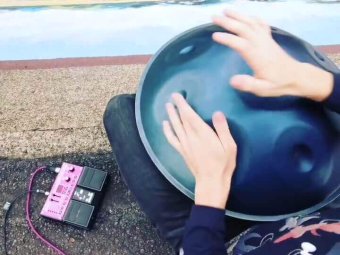Learning the Handpan: Lesson 1 / Simplified Handpan Notation by NovaPans Handpans

There are really two types of musicians; the ones who predominantly play and learn from reading sheet music, and those who play and learn by ear. Those who play by ear are great improvisers such as those who can pick up an instrument and just start playing intuitively. The handpan is a perfect example of a musical instrument whose players have been learning by ear. Any time you've tried to learn a song on the handpan or asked someone to show you something they know you probably just had to watch and learn. As with all musical instruments, however, some form of written notation as a means of independent learning and ordered progress typically comes into birth. Unfortunately, no one seems to have mustered the courage or intuition to get this started so after 20 years of its existence, young man David from a little town in England, CEO of NovaPans, will put his equalled years of classical musical education into creating a notational system for the handpan. And no, it won't involve pretty little pictures of ghosts and coloured circles (see masterthehandpan) (not that these are discouraged for visual learners) but will rather be based on the theories behind traditional music notation. Not to worry though, this won't be complicated because the system we've devised, called Simplified Handpan Notation (SHN) positions the notes of the handpan on the traditional music staves (5 lines) of sheet music in the way in which they appear on the handpan, visually! Quite conveniently, these notes are also ordered correctly from low to high on the staves which keeps it consistent with traditional handpan notation. However, the main difference between SHN and traditional sheet music is that SHN will not necessarily refer to the correct pitches, although it will indicate the note of the handpan to be played.
Check out the video below and see if you can get started with some Simplified Handpan Notation!
Did you find this interesting/useful? Leave us a comment below! Also, don't hesitate to contact us should you have any questions! Check out our other FREE handpan tutorials below:
An Introduction to Sheet Music for the Handpan
Lesson 0.1 / The Touch Technique
Lesson 0.2 / The Handpan Scale
Lesson 1 / Simplified Handpan Notation (Sheet Music for the Handpan)
Lesson 2 / Quaver (Half-Beat) Rhythms
Lesson 3 / Dynamics
Lesson 4 / Accents
Lesson 5 / Semiquaver (1/4 Beat) Rhythms
Lesson 6 / Harmonics & Pitch Pends
Lesson 7 / Percussive Slaps
Lesson 8 / Walking the Hands
Lesson 9 / Chords
Lesson 10 / Triplet Rhythms
Lesson 11 / Ghost Notes
Lesson 12 / Rewriting the Ding
Lesson 13 / Dotted Rhythms
Also, learn these pieces on the handpan! (notation provided):
The Last of the Mohicans (1992 film)
Sam Maher's New York Subway Piece
Discover our handpans
-
Performance Handpans (Generation 3) in Purple
$1,599.00 – $1,699.00 Select options This product has multiple variants. The options may be chosen on the product page All Handpans -
Starter Handpans (Generation 4) in Gold
$799.00 – $999.00 Select options This product has multiple variants. The options may be chosen on the product page All Handpans -
Sound Healing Handpans (Generation 7) in Gold
$1,299.00 – $1,999.00 Select options This product has multiple variants. The options may be chosen on the product page All Handpans
More post about handpans








